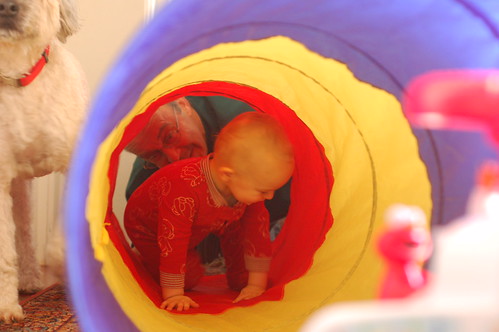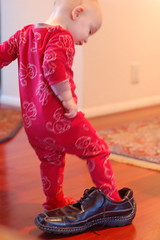



For years now, drug-resistant staph infections have been a problem in hospitals, where the heavy use of antibiotics can create resistant strains of bacteria. It’s Evolution 101: the drugs kill off all but the tiny handful of microbes that, by dint of a chance mutation, possess genes allowing them to withstand the onslaught; these hardy survivors then get to work building a drug-resistant superrace. The methicillin-resistant staph that first emerged in hospitals as early as the 1960s posed a threat mostly to elderly patients. [AND MY UNCLE JEFF!] But a new and even more virulent strain — called “community-acquired MRSA” — is now killing young and otherwise healthy people who have not set foot in a hospital. No one is yet sure how or where this strain evolved, but [experts suspect]... another environment where the heavy use of antibiotics is selecting for the evolution of a lethal new microbe: the concentrated animal feeding operation, or CAFO.
As for independent public-health researchers, they say they can’t study the problem without the cooperation of the livestock industry, which, not surprisingly, has not been forthcoming. For what if these researchers should find proof that one of the hidden costs of cheap meat is an epidemic of drug-resistant infection among young people? There would be calls to revolutionize the way we produce meat in this country. This is not something that the meat and the pharmaceutical industries or their respective regulatory “watchdogs” — the Department of Agriculture and F.D.A. — are in any rush to see happen.

Juanna eloped in 1933 to marry her beau Francesco Antonio Migliore (Doc to his friends and patients) in Washington, DC. They lived there and in Chicago until 1940 before returning to their roots in Price where Doc used his Chiropractic skills to support his family including Michael and Launa (Harvey). Doc died in 1983 and Michael in 1994 as a later-life consequence of service to his country in Vietnam. Juanna also mourned the loss of her sister Bertha (Spratling) and brothers Harry and Robert (Buck).
Juanna was an exceptional seamstress who made beautiful clothes for Launa, many friends in Price, and costumes for her grandchildren Brandon and Megan. This interest led her to work for many years selling materials and sewing notions in Price Trading where her skills and outgoing personality gained her many friends. Juanna and family spent happy times at the cabin Doc built in Scofield, a magical place now used by her children, grandchildren, and great grandson Elliot.
Juanna was a beautiful, independent, friendly, and honest lady who dealt cheerfully with life’s many challenges. Her family would particularly like to thank her neighbor Norma Petrie who helped Juanna achieve her wish to live independently at home in her later years, and the amazing and caring ladies at Hospice especially Jessie who helped make that independence possible. A special thanks also to Drs. Etzel and Boyle. Juanna will be dearly missed by her family and friends.
Funeral services will be held on Saturday Dec 1st at Mitchells Funeral Chapel in Price at 11 am, with a viewing at 10 am. In lieu of flowers please donate to Rocky Mountain Hospice at 60E 100N in Price, or the charity of your choice.
Many obstetricians have never witnessed a natural birth in its entirety, and today, Eisenstein says, a natural birth in a hospital is "almost nonexistent. It was more likely 25 years ago than today." People ask more questions when they buy a car or a house than they do when they choose the care provider and birth location that will be part of one of the most important experiences in the life of a family. All of the doctors are nice, he says, "but you're not hiring your doctor to like [him], you are hiring [him] to have the safest possible birth."
The effect [of lack of sleep] was indeed measurable—and sizable. The performance gap caused by an hour’s difference in sleep was bigger than the normal gap between a fourth-grader and a sixth-grader. Which is another way of saying that a slightly sleepy sixth-grader will perform in class like a mere fourth-grader. “A loss of one hour of sleep is equivalent to [the loss of] two years of cognitive maturation and development,” Sadeh explains.
“While I sat watching her looking so pallid & sick, all at once her breast heaved, and a great worm a foot long & as large as my finger crawled out of her dear little mouth. I was horror struck, with my unconquerable & unutterable antipathy to all reptiles, to see one of that magnitude thrown from the loathing stomach of my child. It was horrible—-I trust she will find relief after rejecting the hideous monster.”
"My little plum's
A stinky plum!
I'm gonna wash
His stinky bum!
I'm gonna make
His bum all clean!
Even it if makes him
Yell and scream!"

The Centers for Disease Control and Prevention consider blood lead amounts under 10 mcg/dl—the amount present in many toddlers—safely below the "level of concern."
How to answer the question, what is more sustainable, leather from cows who emit carbon gas and drink like 200 gallons of water a day and ruin land, or, plastic, which never degrades? Where are the value judgment reports on such things?
How do you pronounce Robeez?
It’s pronounced Rob, as in Robert, the name of the founder’s son; and Eez, as in ease.

